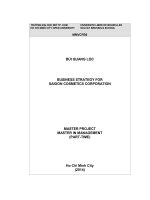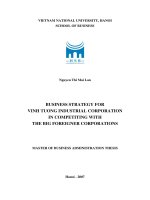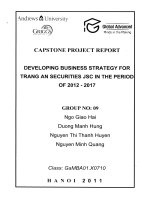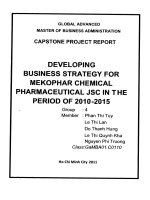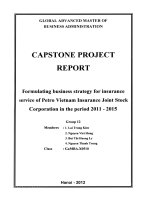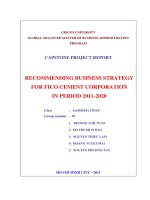Business strategy for Vinh Tuong industrial corporation in competiting with the big foreigner corporations
Bạn đang xem bản rút gọn của tài liệu. Xem và tải ngay bản đầy đủ của tài liệu tại đây (796.83 KB, 92 trang )
VIETNAM NATIONAL UNIVERSITY, HANOI
SCHOOL OF BUSINESS
Nguyen Thi Mai Lan
BUSINESS STRATEGY FOR
VINH TUONG INDUSTRIAL CORPORATION
IN COMPETITING WITH
THE BIG FOREIGNER CORPORATIONS
MASTER OF BUSINESS ADMINISTRATION THESIS
Hanoi - 2007
VIETNAM NATIONAL UNIVERSITY, HANOI
SCHOOL OF BUSINESS
Nguyen Thi Mai Lan
BUSINESS STRATEGY FOR
VINH TUONG INDUSTRIAL CORPORATION
IN COMPETING WITH
THE BIG FOREIGN CORPORATIONS
Major: Business Administration
Code: 60 34 05
MASTER OF BUSINESS ADMINISTRATION THESIS
Supervisors:
1. Dr. Chu Thanh
2. Mr. Ha nguyen, MBA
Hanoi - 2007
vii
TABLE OF CONTENTS
ABSTRACT i
TÓM TẮT iii
ACKNOWLEDGEMENTS vi
TABLE OF CONTENTS vii
INTRODUCTION 1
1. NECESSITY OF THE THESIS 1
2. PURPOSE 1
3. KEY RESEARCH AREA 2
4. METHODOLOGY 2
5. CONTRIBUTIONS OF THE THESIS 2
6. OUTLINE 2
CHAPTER 1: THEORY FOUNDATION
1.1. What is strategy? 4
1.1.1 Definition 4
1.1.2. Strategy at different levels of a business 5
1.1.3. How strategy is managed – strategic management 5
1.2. Analysis tools in building a strategy 8
1.2.1. Competitive advantages 8
1.2.2. Competitor analysis 11
1.2.3. Five forces model 16
1.2.4. SWOT analysis 20
1.2.5. Value chain analysis 23
viii
1.3. Strategic planning 26
1.3.1. Value and vision 26
1.3.2. Mission 28
1.3.3. Objectives 31
CHAPTER 2: CASE STUDY OF VINH TUONG INDUSTRIAL CORPORATION
2.1. Overview of grid ceiling and gypsum board marketing in Viet nam 34
2.1.1. Overview 34
2.1.2. Five forces analysis in 2007 36
2.2. Introduction of Vinh Tuong Corporation 39
2.2.1 Particular traits 39
2.2.2. Performance 40
2.2.3. Brand name 41
2.2.4. Organizational structure 42
2.3. Competition situation 47
2.3.1. History story of VTI 47
2.3.2. Introduction of La Farge and BPB 48
2.3.3. Competitors analysis 50
CHAPTER 3: RECOMMENDATIONS
3.1. Strategic planning 56
3.1.1. Vision 56
3.1.2. Mission 56
3.1.3. Objects 56
3.2. Strategic analysis 57
3.2.1. Value chain analysis 57
ix
3.2.2. Competitive advantages 61
3.2.3. SWOT analysis 62
3.2.4. SWOT matrix to form strategies 64
3.3. Strategic choice 68
3.3.1. The strategy of developing new products 67
3.3.2. The strategy of integrating back 68
3.3.3. The strategy of integrating forth 69
3.3.4. The strategy of growing market 69
3.3.5. The strategy of reorganizing the business 70
3.3.6. The strategy of differentiation in competition 70
3.4. Strategic implementation 72
3.4.1. Managerial implementation 72
3.4.2. Marketing 77
3.4.3. Finance 79
3.4.4. Researching and developing 79
3.4.5. Information system management 80
3.4.6. Time table of implementation 81
3.5. Recommendation 81
CONCLUSION 83
REFERENCES 84
x
LIST OF TABLES
CHAPTER 1 Page
TABLE
1.1. Sources of competitor data 14
1.2. SWOT analysis 22
1.3. SWOT matrix 23
CHAPTER 2
TABLE
2.1 Organizational structure of VTI 44
2.2 Organizational structure of Southern area 45
2.3 Organizational structure of Northern area 45
CHAPTER 3
TABLE
3.1 Competitive position 62
3.2 SWOT matrix 66
xi
LIST OF FIGURES
CHAPTER 1 Page
FIGURE
1.1. A thorough strategic management process 6
1.2 The matrix for strategic choice 7
1.3 The four strategies 9
1.4 Michael Porter's Five Forces Model 16
CHAPTER 2
FIGURE
2.1 The consumption of gypsum board in some ASEAN countries 35
2.2 The consumption of gypsum board in Viet Nam (a+b) 35,36
2.3 Turnover of VT2 of the years of 2000 -2005 41
2.4 Quantity and Qualification of Employees of VTI 46
2.5 Qualification of Employees of VTI 47
CHAPTER 3
FIGURE
3.1 Annual objects of VTI for the period of 2007 – 2010 74
xii
LIST OF ILLUSTRATIONS
CHAPTER 2 Page
ILLUSTRATIONS
2.1 Gypsum Division locations of Lafarge in the world 49
2.2 Market share of Gypsum board in Vietnam 52
CHAPTER 3
ILLUSTRATIONS
3.1 Turnover percentage of geographic areas of market 77
1
INTRODUCTION
1. NECESSITY OF THE THESIS
Strategic management is a necessary job of all managers. In business
operation, strategy is a tool to support the corporation gain it objects,
mission, and vision. Especially in competition, strategic management even
keeps an important role in conducting the companies. It has a main effect on
existence, growing, and developing of an enterprise. A company can win lots
of success, if it has right strategies for its situation.
Vinh Tuong Industrial Corporation (VTI) is a Vietnamese business. At the
time, it is facing to the stressful competition with two big international
corporations. To keep strongly the position of leader in domestic market as
well as to gain the purpose of growing and developing the business, the
company must set up the suitable strategies in the new challenge period.
Through the working time at VTI, I am interested in joining to contribute the
business strategies for company. Therefore, I decide to the topic: “Business
strategy for Vinh Tuong Industrial Corporation in competing with the big
foreign Corporations.”
2. PURPOSE
- Research the issues about strategic management of business including the
analysis tools, the strategic chosen, and the strategic implementation.
- Research the real situation of the company of VTI at the moment.
- Apply the issues of strategic management for building up the right
effective strategies for the company in practice.
2
3. KEY RESEARCH AREA
Research and apply the strategic management in business is the main topic.
Thesis only concentrates on using the tools to analyze the current situation of
VTI. By the way, it sets up the strategies chosen. Then, it presents the ways
to implement the strategies in practice operation.
4. METHODOLOGY
First, the thesis bases on the real issues of the case study of Vinh Tuong
Industrial Corporation in competing with two big foreign groups.
Second, thesis is used methodology of descriptive analysis, logic reason
combination materialistic history. The data is drawn from the primary and
secondary sources. The methods of collecting data are taking researches, and
expert advices from theory foundation and personal experience.
Finally, thesis is also used statistic, formula illustration, interpreting the
issues means.
5. CONTRIBUTIONS OF THE THESIS
- Introduce all process of setting up the strategic management for a
business.
- Apply the issues in the real situation of VTI to analyze the information,
bring out the strategic chosen, and present the ways to implement the
strategies in practicing conduction of the company.
6. OUTLINE
Topic: “Business strategy for Vinh Tuong Industrial Corporation in
competing with the big foreign Corporations.”
3
The content of the thesis includes:
Preface
Introduction
Chapter 1: Theory foundation – Strategy and analysis tools
Chapter 2: Case Study of Vinh Tuong Industrial Corporation
Chapter 3: Recommendations and Conclusions - Business strategy for
Vinh Tuong Industrial Corporation in competing with the big foreign
Corporations.
Conclusion
Reference
4
CHAPTER 1: THEORY FOUNDATION
STRATEGY AND ANALYSIS TOOLS
1.1. WHAT IS STRATEGY?
1.1.1. Definition
Overall Definition:
Johnson and Scholes (Exploring Corporate Strategy) define strategy
as follows:
"Strategy is the direction and scope of an organisation over the long-
term: which achieves advantage for the organisation through its
configuration of resources within a challenging environment, to meet
the needs of markets and to fulfill stakeholder expectations".
In other words, strategy is about:
* Where is the business trying to get to in the long-term (direction)?
* Which markets should a business compete in and what kinds of
activities are involved in such markets? (markets; scope)
* How can the business perform better than the competition in those
markets? (advantage)?
* What resources (skills, assets, finance, relationships, technical
competence, facilities) are required in order to be able to compete?
(resources)?
5
* What external, environmental factors affect the businesses' ability to
compete? (environment)?
* What are the values and expectations of those who have power in
and around the business? (stakeholders)
1.1.2. Strategy at different levels of a Business
Strategies exist at several levels in any organization - ranging from the
overall business (or group of businesses) through to individuals
working in it.
Corporate Strategy - is concerned with the overall purpose and scope
of the business to meet stakeholder expectations. This is a crucial
level since it is heavily influenced by investors in the business and
acts to guide strategic decision-making throughout the business.
Corporate strategy is often stated explicitly in a "mission statement".
Business Unit Strategy - is concerned more with how a business
competes successfully in a particular market. It concerns strategic
decisions about choice of products, meeting needs of customers,
gaining advantage over competitors, exploiting or creating new
opportunities etc.
Operational Strategy - is concerned with how each part of the
business is organized to deliver the corporate and business-unit level
strategic direction. Operational strategy therefore focuses on issues of
resources, processes, people etc.
1.1.3. How strategy is managed – strategic management
In its broadest sense, strategic management is about taking "strategic
decisions" - decisions that answer the questions above.
6
In practice, a thorough strategic management process has three main
components, shown in the figure below:
Figure 1.1 – a thorough strategic management process
Strategic Analysis
This is all about the analyzing the strength of businesses' position and
understanding the important external factors that may influence that
position. The process of Strategic Analysis can be assisted by a
number of tools that will be presented in the next part.
Strategic Choice
The process involves understanding the nature of stake holder
expectations (the “ground rules”), identifying strategic options, and
then evaluating and selecting strategic options.
Normally, the business can use the matrix of strategic choice to decide
what its best strategies are.
7
Figure 1.2 - The matrix for strategic choice.
Strategy Implementation
1. Entry new market
2. Penetrate current market
3. Develop the product
4. Integrate in horizon
5. Eliminating
6. Liquidating
1. Entry new market
2. Penetrate current market
3. Develop the product
4. Integrate forth
5. Integrate back
6. Integrate in horizon
7. Diversify in focus a
centre
1. Reduce expense
2. Diversify in focus a
centre
3. Diversify in horizon
4. Diversify in combining
5. Eliminating
6. Liquidating
1. Diversify in focus a
centre
2. Diversify in horizon
3. Diversify in combining
4. Join venture
The growing rate of market
The competitive position of the business
Slow
Quick
Strong
Weak
8
This is often the hardest part. When a strategy has been analyzed and
selected, the task is then to translate it into organizational actions.
They include the action plans of administrative management,
marketing, finance, R&D, information system management.
1.2. ANALYSIS TOOLS IN BUILDING A STRATEGY
1.2.1. Competitive advantages
Competitive Advantage - Definition
A competitive advantage is an advantage over competitors gained by
offering consumers greater value, either by means of lower prices or
by providing greater benefits and service that justifies higher prices.
Competitive Strategies
Following on from his work analysing the competitive forces in an
industry, Michael Porter suggested four "generic" business strategies
that could be adopted in order to gain competitive advantage. The four
strategies relate to the extent to which the scope of a businesses'
activities are narrow versus broad and the extent to which a business
seeks to differentiate its products.
The four strategies are summarized in the figure below:
9
Figure 1.3. – The four strategies
The differentiation and cost leadership strategies seek competitive
advantage in a broad range of market or industry segments. By
contrast, the differentiation focus and cost focus strategies are
adopted in a narrow market or industry.
Strategy - Differentiation
This strategy involves selecting one or more criteria used by buyers in
a market - and then positioning the business uniquely to meet those
criteria. This strategy is usually associated with charging a premium
price for the product - often to reflect the higher production costs and
extra value-added features provided for the consumer. Differentiation
is about charging a premium price that more than covers the
additional production costs, and about giving customers clear reasons
to prefer the product over other, less differentiated products.
Examples of Differentiation Strategy: Mercedes cars; Bang & Olufsen
10
Strategy - Cost Leadership
With this strategy, the objective is to become the lowest-cost producer
in the industry. Many (perhaps all) market segments in the industry
are supplied with the emphasis placed minimizing costs. If the
achieved selling price can at least equal (or near) the average for the
market, then the lowest-cost producer will (in theory) enjoy the best
profits. This strategy is usually associated with large-scale businesses
offering "standard" products with relatively little differentiation that
are perfectly acceptable to the majority of customers. Occasionally, a
low-cost leader will also discount its product to maximize sales,
particularly if it has a significant cost advantage over the competition
and, in doing so, it can further increase its market share.
Examples of Cost Leadership: Nissan; Tesco; Dell Computers
Strategy - Differentiation Focus
In the differentiation focus strategy, a business aims to differentiate
within just one or a small number of target market segments. The
special customer needs of the segment mean that there are
opportunities to provide products that are clearly different from
competitors who may be targeting a broader group of customers. The
important issue for any business adopting this strategy is to ensure
that customers really do have different needs and wants - in other
words that there is a valid basis for differentiation - and that existing
competitor products are not meeting those needs and wants.
Examples of Differentiation Focus: any successful niche retailers;
(e.g. The Perfume Shop); or specialist holiday operator (e.g. Carrier)
11
Strategy - Cost Focus
Here a business seeks a lower-cost advantage in just on or a small
number of market segments. The product will be basic - perhaps a
similar product to the higher-priced and featured market leader, but
acceptable to sufficient consumers. Such products are often called
"me-too's".
Examples of Cost Focus: Many smaller retailers featuring own-label
or discounted label products.
1.2.2. Competitor analysis
Competitor Analysis is an important part of the strategic planning
process. This revision note outlines the main role of, and steps in,
competitor analysis
Why bother to analyse competitors?
Some businesses think it is best to get on with their own plans and
ignore the competition. Others become obsessed with tracking the
actions of competitors (often using underhand or illegal methods).
Many businesses are happy simply to track the competition, copying
their moves and reacting to changes.
Competitor analysis has several important roles in strategic planning:
• To help management understand their competitive advantages/
disadvantages relative to competitors
• To generate understanding of competitors’ past, present (and most
importantly) future strategies
12
• To provide an informed basis to develop strategies to achieve
competitive advantage in the future
• To help forecast the returns that may be made from future
investments (e.g. how will competitors respond to a new product
or pricing strategy?
Questions to ask
What questions should be asked when undertaking competitor
analysis? The following is a useful list to bear in mind:
• Who are our competitors? (see the section on identifying
competitors further below)
• What threats do they pose?
• What is the profile of our competitors?
• What are the objectives of our competitors?
• What strategies are our competitors pursuing and how successful
are these strategies?
• What are the strengths and weaknesses of our competitors?
• How are our competitors likely to respond to any changes to the
way we do business?
Sources of information for competitor analysis
Davidson (1997) describes how the sources of competitor information
can be neatly grouped into three categories:
13
• Recorded data: this is easily available in published form either
internally or externally. Good examples include competitor annual
reports and product brochures;
• Observable data: this has to be actively sought and often
assembled from several sources. A good example is competitor
pricing;
• Opportunistic data: to get hold of this kind of data requires a lot
of planning and organization. Much of it is “anecdotal”, coming
from discussions with suppliers, customers and, perhaps, previous
management of competitors.
The table below lists possible sources of competitor data using
Davidson’s categorization:
Recorded Data
Observable Data
Opportunistic Data
Annual report &
accounts
Pricing / price lists
Meetings with suppliers
Press releases
Advertising
campaigns
Trade shows
Newspaper articles
Promotions
Sales force meetings
Analysts reports
Tenders
Seminars / conferences
Regulatory reports
Patent applications
Recruiting ex-
employees
Government reports
Discussion with shared
distributors
14
Presentations/ speeches
Social contacts with
competitors
Table 1.1. - Sources of competitor data
In his excellent book [Even More Offensive Marketing], Davidson
likens the process of gathering competitive data to a jigsaw puzzle.
Each individual piece of data does not have much value. The
important skill is to collect as many of the pieces as possible and to
assemble them into an overall picture of the competitor. This enables
you to identify any missing pieces and to take the necessary steps to
collect them.
What businesses need to know about their competitors?
The tables below lists the kinds of competitor information that would
help businesses complete some good quality competitor analysis.
You can probably think of many more pieces of information about a
competitor that would be useful. However, an important challenge in
competitor analysis is working out how to obtain competitor
information that is reliable, up-to-date and available legally (!).
What business probable already know their competitors?
Overall sales and profits
Sales and profits by market
Sales by main brand
Cost structure
15
Market shares (revenues and volumes)
Organization structure
Distribution system
Identity/profile of senior management
Advertising strategy and spending
Customer/consumer profile & attitudes
Customer retention levels
What businesses would really like to know about competitors?
Sales and profits by product
Relative costs
Customer satisfaction and service levels
Customer retention levels
Distribution costs
New product strategies
Size and quality of customer databases
Advertising effectiveness
Future investment strategy
Contractual terms with key suppliers
Terms of strategic partnerships
16
1.2.3. Five forces model
Defining an industry
An industry is a group of firms that market products which are close
substitutes for each other (e.g. the car industry, the travel industry).
Some industries are more profitable than others. Why? The answer
lies in understanding the dynamics of competitive structure in an
industry.
The most influential analytical model for assessing the nature of
competition in an industry is Michael Porter's Five Forces Model,
which is described below:
Figure 1.4. - Michael Porter's Five Forces Model
17
Porter explains that there are five forces that determine industry
attractiveness and long-run industry profitability. These five
"competitive forces" are
- The threat of entry of new competitors (new entrants)
- The threat of substitutes
- The bargaining power of buyers
- The bargaining power of suppliers
- The degree of rivalry between existing competitors
Threat of New Entrants
New entrants to an industry can raise the level of competition, thereby
reducing its attractiveness. The threat of new entrants largely depends
on the barriers to entry. High entry barriers exist in some industries
(e.g. shipbuilding) whereas other industries are very easy to enter (e.g.
estate agency, restaurants). Key barriers to entry include:
- Economies of scale
- Capital / investment requirements
- Customer switching costs
- Access to industry distribution channels
- The likelihood of retaliation from existing industry players.
